Do you want to add a lush, vibrant touch of colour to your garden this summer? Then consider the classic flower nasturtium for an easy splash of reds, oranges, and yellows! Not only are they beautiful in their own right, but they’re also amazing companion plants.
Nasturtiums have a plethora of benefits that can help create strong and healthy plant communities around them…and by selecting the right partners you can further increase those advantages!
In this article, we’ll explore some great companion plants for your nasturtiums and how to use them for the best results. So get ready to take your gardening game up a notch with these creative ideas –– let’s start planting!
Nasturtium Companion Plants
Lettuce
Lettuce is one of the most popular companion plants for nasturtiums – and with good reason! This leafy green acts as a shade provider in hot climates, keeping soil temperatures cool and hindering evaporation.
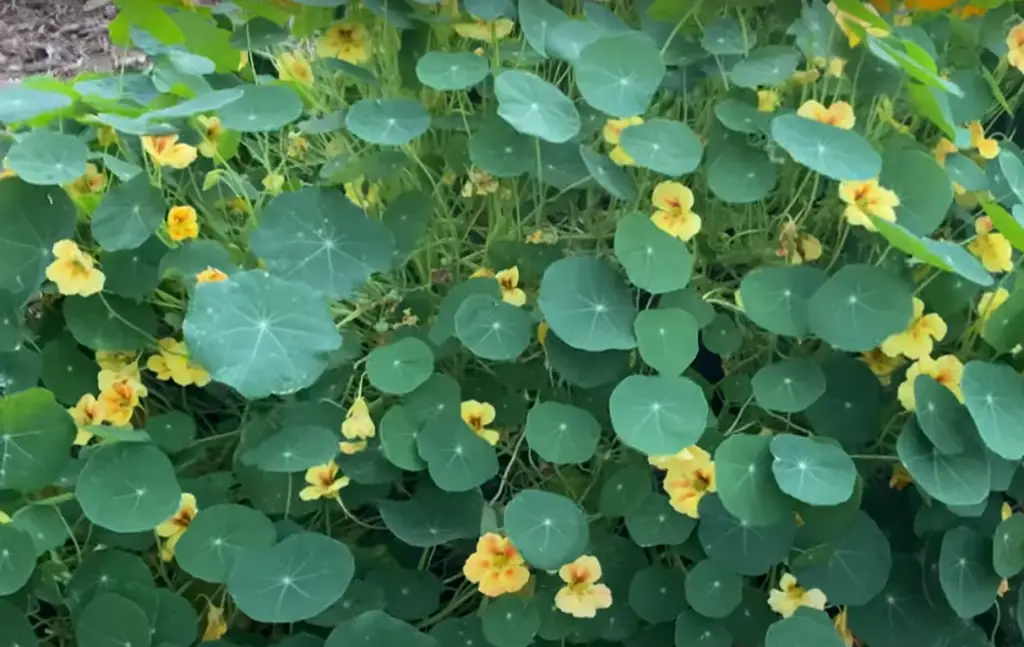
The combo of these two plants also helps to attract beneficial pollinators like bees and butterflies.
Radishes
Radishes are also great for planting alongside nasturtiums due to their deep-rooting quality.
They create nutrient-rich soil below the surface, allowing your nasturtiums to find all the nutrients they need without having to compete with other plants for water or food. Plus, these root vegetables add a delightful spicy flavour when used in salads and dishes.
Marigolds
Marigolds are the perfect companion for nasturtiums because of their complementary colour palette and resistance to pests.
Not only do they look beautiful side-by-side, marigolds also act as natural insect repellents which can help protect your nasturtiums from pesky predators.
Dill
Dill is a great herb to have around if you’re looking to attract beneficial insects like ladybugs and hoverflies, which are essential for keeping your nasturtiums safe from aphids and other pests. Plus, it adds a delightful anise-like flavour that can be used in salads and soups.
Sunflowers
Sunflowers are a stunning addition to your garden, and they make for great nasturtium companions too!
As tall as they can get, these sunny beauties provide much-needed shade for your nasturtiums while attracting pollinators like bees and butterflies with their bright petals.
How to Collect Nasturtium Seeds
Once your nasturtiums have bloomed and gone to seed, it’s time to collect them for planting next season!
To harvest seeds from a nasturtium, simply twist off the dried seed pods and place them in a paper bag. Keep the bag in a cool, dry spot until you’re ready for planting.
You can store nasturtium seeds for up to two years before planting, but they’ll still remain viable if kept in a cool, dark place. That said, it’s best to sow them as soon as possible so that you have the best chance of a successful harvest!
Nasturtium Soil and pH Requirements
Nasturtiums are known for their versatility and adaptability, but there are still some environmental conditions that they need to thrive.
The Best Way to Water Nasturtiums
Nasturtiums prefer well-draining soil and should be watered deeply. It’s best to water them in the morning so that they have plenty of time to dry out before nightfall.

You can also use mulch around the base of the plant to help retain moisture and keep weeds away, as well as collect rainwater if you live in an area with frequent rainfall.
Common Nasturtium Pests and Diseases
Nasturtiums are fairly low-maintenance plants, and they don’t tend to be affected by many pests or diseases. However, it’s still important to keep an eye out for potential issues like aphids, whiteflies, and powdery mildew. If you do find any of these critters on your nasturtiums, the best solution is to remove them by hand or use horticultural oil if needed.
Growing Nasturtium: Tips & Tricks
Nasturtiums make for great indoor or outdoor plants, and they can be grown from seed or cuttings. You can also plant them in containers or raised beds if you’re growing indoors, allowing for easy access to sunlight and water.
It’s important to keep the soil moist but not soggy, as nasturtiums don’t like too much overwatering. Additionally, make sure to fertilise your nasturtiums every few weeks with a balanced liquid fertiliser for optimal growth.
Do Nasturtiums Need Full Sun?
Nasturtiums are considered sun lovers, but they can also tolerate partial shade. That said, it’s best to give them at least four hours of direct sunlight every day for the most vibrant blooms!
If you’re growing indoors, place your pots near a sunny window or set up some grow lights to ensure they get enough light.
Is Nasturtium an Annual or Perennial?
Nasturtiums are annual plants, meaning they live for one season and then die off. That said, they can reseed themselves and come back the next year if given the chance.
Are Nasturtiums Edible Plants?
Yes! Nasturtiums are edible plants and their leaves, flowers, and even seeds can be eaten. The leaves have a peppery taste that makes them great for adding some kick to salads or sandwiches, while the beautiful petals can be used as garnishes or dried and preserved for later use.
Lastly, the seeds make a delicious addition to pickles or relishes. So don’t be shy –– go ahead and give these tasty plants a try!
Recommended Nasturtium Varieties
There are many different varieties of nasturtiums, each with its own unique characteristics. For a beautiful and easy-to-grow variety, try Tropaeolum nanum ‘Alaska’, which is an old-fashioned favourite with large, showy flowers that come in shades of yellow, orange and red.
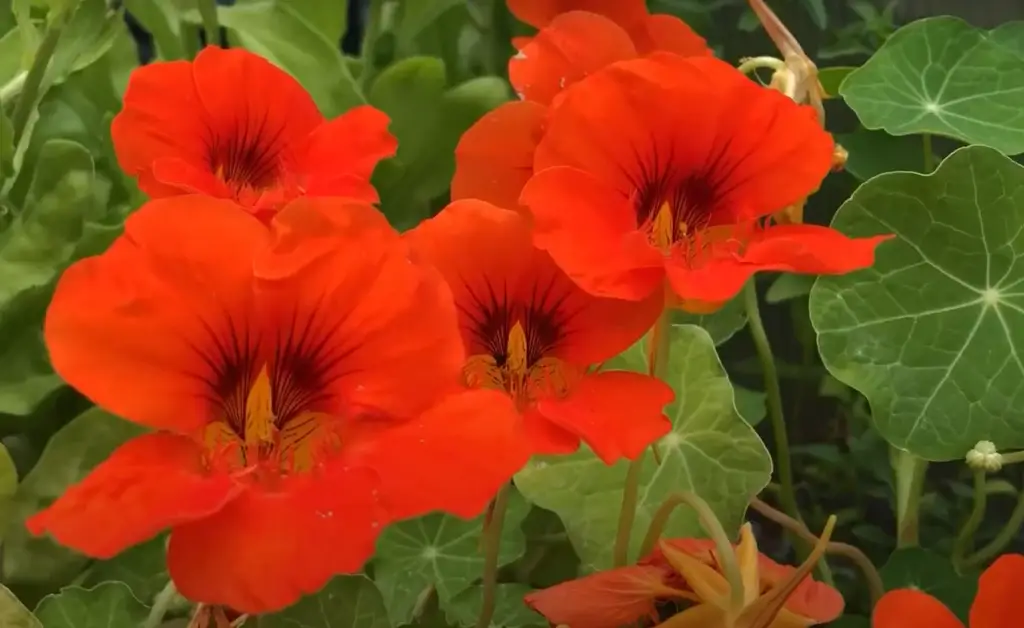
If you want something more exotic, there’s Tropaeolum majus ‘Cherry Rose’, which produces stunning dark-pink flowers with bright yellow centres.
And finally, for something that will really stand out in your garden, try the trailing variety Tropaeolum peregrinum ‘Canary Creeper’ –– its vibrant canary-yellow blooms are sure to turn heads!
FAQ
What should you not plant next to nasturtiums?
It’s best to avoid planting nasturtiums next to other plants that may compete for resources, such as tomatoes or potatoes. Additionally, you should also avoid planting them too close to herbs like cilantro and fennel, as the flavour can overpower the delicate taste of nasturtiums.
Can you eat nasturtiums?
Yes, nasturtiums are edible plants and their leaves, flowers, and even seeds can be eaten. The leaves have a peppery taste that makes them great for adding some kick to salads or sandwiches, while the beautiful petals can be used as garnishes or dried and preserved for later use.
Lastly, the seeds make a delicious addition to pickles or relishes. So don’t be shy –– go ahead and give these tasty plants a try!
Is nasturtium a nitrogen fixer?
No, nasturtiums are not nitrogen-fixing plants. While they do add some nitrogen to the soil as they decompose, it’s not enough to have a significant impact on surrounding plants. For an effective nitrogen fixer, try growing beans or peas instead!
Are nasturtium leaves poisonous?
No, nasturtium leaves are not poisonous. In fact, they’re quite edible and often used in salads or sandwiches for their peppery taste! That said, it’s important to avoid eating flowers or seeds if you have any kind of food allergy. It’s also best to purchase your nasturtiums from a reputable source if you plan on consuming them.
Where best to grow nasturtium?
Nasturtiums make for great indoor or outdoor plants, and they can be grown from seed or cuttings. They prefer well-draining soil and should be watered deeply in the morning so that they have plenty of time to dry out before nightfall. When it comes to sunlight, nasturtiums are considered sun lovers but can also tolerate partial shade –– just make sure they get at least four hours of direct sunlight every day.
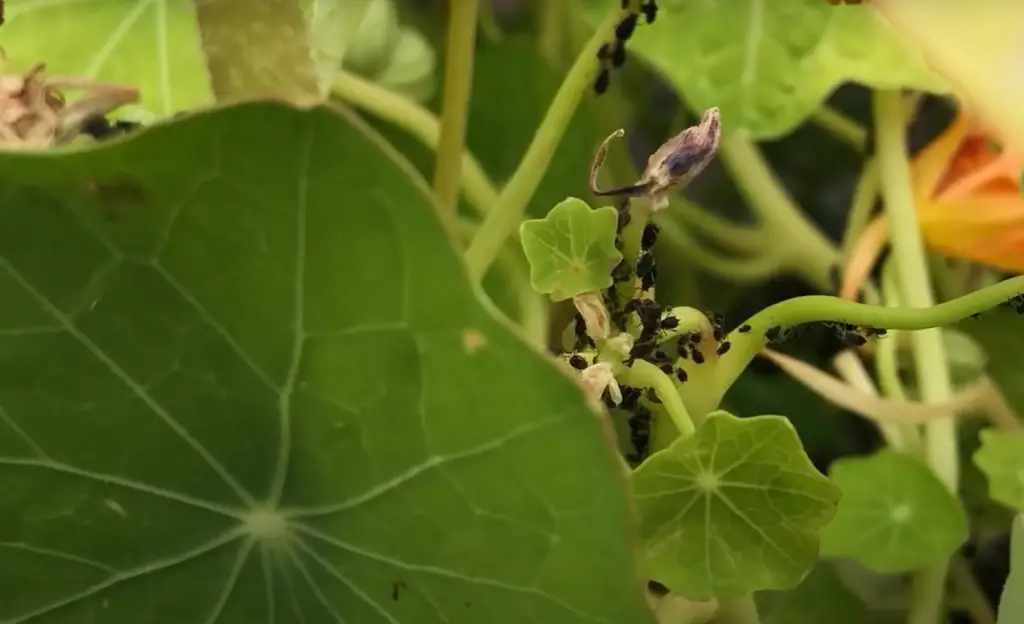
Lastly, if you’re growing indoors, place your pots near a sunny window or set up some grow lights to ensure they get enough light.
Can nasturtiums be grown in containers?
Yes, nasturtiums can be grown in containers! They make for great indoor plants, and growing them in containers allows for easy access to sunlight and water. Just make sure to use a good-quality potting mix and provide adequate drainage –– nasturtiums don’t like too much overwatering.
Additionally, you can fertilise your nasturtiums every few weeks with a balanced liquid fertiliser for optimal growth.
Can nasturtiums climb?
Yes, some varieties of nasturtiums are climbers and can be trained to grow up trellises or other supports.
The trailing variety Tropaeolum peregrinum ‘Canary Creeper’ is a popular choice for this purpose, as its vibrant canary-yellow blooms will make a stunning display when grown on a vertical surface.
Can you grow nasturtiums in pots?
Yes, nasturtiums can be grown in pots! Whether you’re growing indoors or outdoors, make sure to use a good-quality potting mix and provide adequate drainage –– nasturtiums don’t like too much overwatering.
Additionally, fertilise your nasturtiums every few weeks with a balanced liquid fertiliser for optimal growth.
And when it comes to sunlight, nasturtiums are considered sun lovers but can also tolerate partial shade –– just make sure they get at least four hours of direct sunlight every day.
Do nasturtiums attract bees?
Yes, nasturtiums are great for attracting bees and other beneficial pollinators to your garden. The vibrant blossoms provide an excellent source of nectar for these helpful creatures, making them a valuable addition to any landscape!
Plus, the more pollinators you have in your garden, the better it will be for your other plants.
Does nasturtium spread?
Yes, nasturtiums do spread –– in fact, they can become quite invasive if not kept in check.
Additionally, you can also put down some ground cover or weed barrier fabric to help keep the roots contained and stop them from spreading too far.
What animals eat nasturtium?
Nasturtiums can be a tasty snack for many different types of animals –– from birds and deer to rabbits, squirrels and other small mammals.
So if you don’t want your plants to get eaten by wildlife, it’s best to put up some kind of fence or barrier around them.
Additionally, you can also try planting nasturtiums in containers, as this will help to keep them safe from hungry critters!
Are nasturtiums annual or perennial?
Nasturtiums are usually grown as annual plants, meaning they have a lifespan of just one year.
However, if you live in an area with mild winters and no frost, you may be able to get away with planting them as perennials –– just make sure to provide enough water and fertiliser throughout the year for optimal growth.
Are nasturtiums deer resistant?
Yes, nasturtiums are generally considered deer-resistant plants. That said, they can still be vulnerable to hungry wildlife –– especially if they’re planted in the ground and not contained in a pot or container.

So it’s always best to take extra precautions and put up some kind of physical barrier around your plants if you live in an area with lots of deer.
What colours do nasturtiums come in?
The wide range of nasturtium varieties available today means you can find plants in a variety of different colours, including yellow, orange, red and pink. And if that’s not enough to choose from, you can even try mixing and matching different colour varieties for an extra-unique look!
How do you propagate nasturtiums?
Nasturtiums are relatively easy to propagate, and there are a few different ways to go about it. The easiest method is to take cuttings from existing plants –– simply snip a stem with several leaves at the base and stick it into some moist soil or a pot filled with water.
You can also try dividing existing plants, or collecting and sowing the seeds from mature plants. Whichever method you choose, just make sure to provide plenty of sunlight and water for optimal growth!
How do you care for nasturtiums?
Caring for nasturtiums is relatively straightforward. They prefer well-draining soil and should be watered deeply in the morning so that they have plenty of time to dry out before nightfall.
When it comes to sunlight, nasturtiums are considered sun lovers but can also tolerate partial shade –– just make sure they get at least four hours of direct sunlight every day.
Additionally, you can fertilise your nasturtiums every few weeks with a balanced liquid fertiliser for optimal growth. Finally, keep an eye out for pests and diseases, and remove any dead or damaged leaves as soon as possible to prevent them from spreading.
Are nasturtiums edible?
Yes, nasturtiums are edible! The flowers, leaves and seeds can all be eaten raw or cooked –– just make sure they haven’t been sprayed with any chemicals before eating.
Additionally, the unripe seed pods can be pickled to use as a spicy substitute for capers. So take advantage of these versatile plants and enjoy their delicious taste!
Can nasturtiums be grown indoors?
Yes, nasturtiums can definitely be grown indoors! In fact, they make for great indoor plants, as the bright colours are sure to add a pop of colour to any room. Plus, growing them in containers allows for easy access to sunlight and water, making it simpler to give your plants the care they need.
Just make sure to use a good-quality potting mix and provide adequate drainage –– nasturtiums don’t like too much overwatering. Lastly, fertilise your nasturtiums every few weeks with a balanced liquid fertiliser for optimal growth.
Are nasturtiums toxic to cats and dogs?
No, nasturtiums are not considered toxic to cats and dogs. However, as with any plant, it’s best to keep them out of reach of your pet just in case they decide to take a nibble.
Additionally, you should also make sure to keep your nasturtiums in a pot or container if you have pets –– this will help to prevent them from accidentally ingesting any of the plants’ leaves or flowers.
Are nasturtiums good for containers?
Yes, nasturtiums can be great plants for containers! Not only do they provide vibrant pops of colour, but they also require minimal care and attention. Plus, growing them in a pot or container allows you to keep an eye on their soil moisture levels and make sure they’re getting the right amount of water and nutrients.
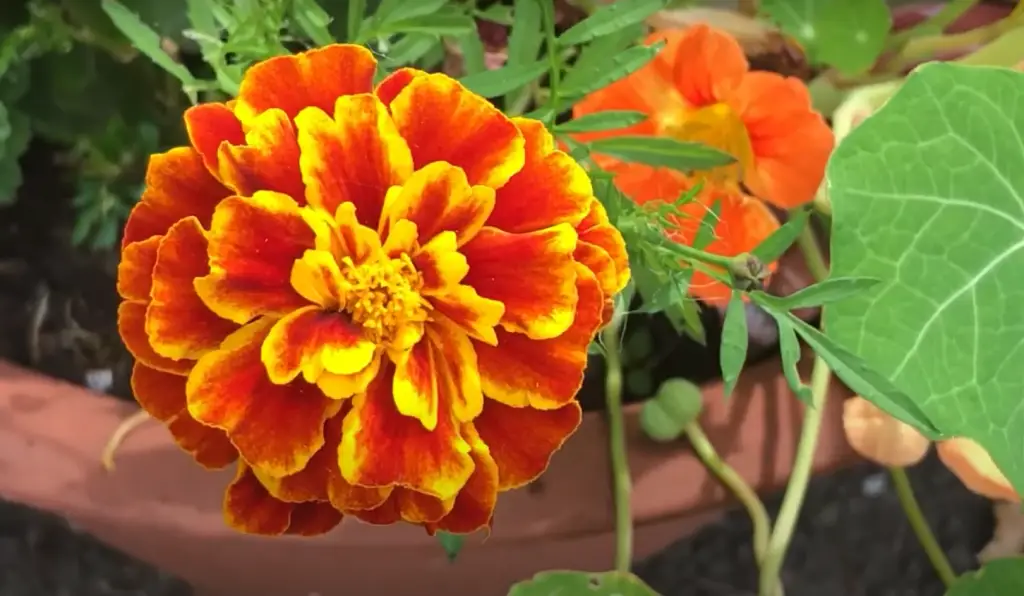
Just make sure to use a good-quality potting mix and provide adequate drainage –– nasturtiums don’t like too much overwatering.
How do you attract pollinators to nasturtiums?
Nasturtiums are great for attracting pollinators such as bees, butterflies and hummingbirds. To make them even more appealing to these creatures, consider planting a variety of different coloured nasturtiums in your garden –– this will ensure that there is something for every type of pollinator to enjoy!
Additionally, you can also try planting flowers that are known to attract pollinators nearby –– this will help to draw them in and keep them busy for longer.
Finally, make sure your nasturtiums are getting plenty of sunlight and water for optimal growth –– this will ensure they look their best and remain healthy throughout the season.
How do you harvest nasturtium seeds?
When harvesting nasturtium seeds, it’s best to wait until the seedpods have turned a dark brown colour and are starting to dry out. At this point, they should be ready to collect –– simply snip off the pods with scissors or pruners and place them in a paper bag for drying.
Once the pods have completely dried out, you can open them up and collect the seeds inside. Be sure to store your harvested nasturtium seeds in a cool, dry place –– this will ensure they stay viable for years to come!
How do you store nasturtium seeds?
It’s best to store nasturtium seeds in an airtight container in a cool, dry place. This will help to keep them away from moisture and humidity, which can cause the seeds to spoil or germinate prematurely.
Additionally, you should also label your containers with the date of harvest so that you know exactly how old the seeds are. With proper storage, your nasturtium seeds should stay viable for up to five years!
How do you use nasturtiums in cooking?
Nasturtiums can be used in a variety of different ways in the kitchen. The flowers and leaves make great additions to salads, while the unripe seed pods can be pickled and used as a spicy substitute for capers.
You can also try adding nasturtium petals to soups and sauces for a unique, peppery flavour.
However you choose to use them, just make sure to always wash your nasturtiums thoroughly before eating –– this will help to remove any dirt or debris that may have accumulated on the plant.
Does nasturtium have any medicinal uses?
Yes, nasturtium has many medicinal uses. For example, the leaves and flowers are commonly used as a diuretic to help flush out toxins from the body. Additionally, they are believed to be helpful in treating respiratory illnesses such as bronchitis and asthma.
Finally, the seedpods can be made into a poultice and applied topically to help reduce inflammation and heal wounds.
However, it’s important to note that the medicinal uses of nasturtiums have not been scientifically proven –– if you’re considering using them for medical purposes, be sure to speak with your doctor first.
Are there any other benefits of growing nasturtiums?
Yes, in addition to their culinary and medicinal uses, nasturtiums also have many other benefits. For instance, they can help to repel certain pests from your garden –– the strong scent of the leaves and flowers has been known to ward off aphids, caterpillars and beetles. Plus, they can act as a natural fertiliser by releasing nitrogen into the soil. So not only are they a great addition to your garden, but they can also help keep it healthier as well!
Do nasturtiums need to be pruned?
No, nasturtiums don’t need to be pruned. In fact, they prefer not to be –– if you do decide to prune them, make sure that only the old or damaged stems are removed and leave all of the healthy growth intact.
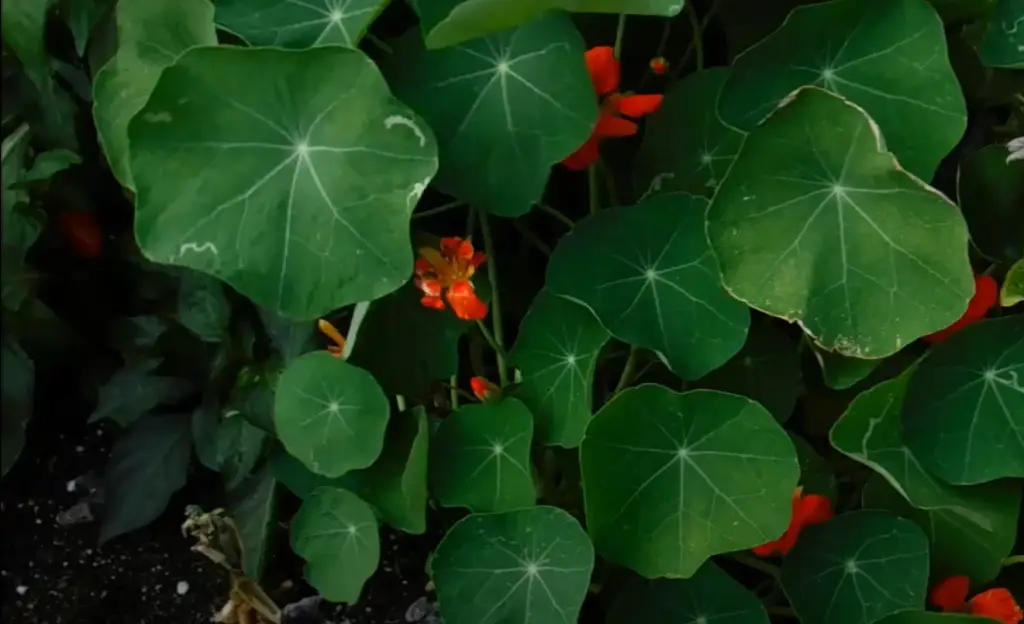
Additionally, it’s important to note that nasturtiums don’t require much maintenance at all –– just make sure to water them regularly and fertilise them every few weeks with a balanced liquid fertiliser, and you should be good to go.
Are nasturtiums drought-tolerant?
Yes, nasturtiums are quite drought-tolerant plants. However, they do need to be watered regularly and given a good soak every now and then in order to remain healthy and vibrant.
When watering your nasturtiums, make sure not to overwater them –– as mentioned earlier, they don’t like too much moisture!
Additionally, it’s best to water them in the early morning or late evening when temperatures are cooler –– this will help to prevent evaporation and keep the soil moist for longer.
Useful Video: Companion Planting with Nasturtium | Edible Flower Gardening
Conclusion
Whether you are a seasoned gardener or just beginning your green thumb journey, nasturtiums can add another layer of life and texture to your garden. Nasturtium companion plants create an atmosphere of collaboration and connection that supports the success of all plants involved.
Pairing your nasturtiums with plants such as lettuce, cucumber, kale, beans, and melons will surely add even more variety to your garden. And with these great suggestions hopefully you no longer have to worry about pests taking over your garden!
So go out there and give nasturtium companion planting a try to make sure you get the most delightful yield from each and every plant in your garden! From extended blooms in your flowers to flavorful fruits in your veggies – it’s sure to be everything you need it to be.
After all, learning how to effectively use companion plants is not only helpful but rewarding too!
References:
- https://kellogggarden.com/blog/gardening/growing-nasturtium-companion-plants-tips-and-tricks/










Leave a Reply
View Comments